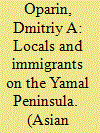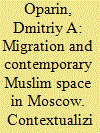| Srl | Item |
| 1 |
ID:
157958


|
|
|
|
|
| Summary/Abstract |
Western Siberia and the entire Arctic region have been a beacon for migrants from the European part of Russia, from the national republics and the southern regions of Siberia in the post-war era. In contrast with the other regions of Siberia, the oil- and gas-rich North remains a magnet for migration from the entire former Soviet Union to this day. This paper presents research into the contemporary sociocultural environment of Yar-Sale, the administrative centre of the Yamal district of Yamalo-Nenets Autonomous Okrug. The research focuses on the migrational experiences of ‘new’ migrants and their relations with the native Nenets population. Special attention is paid to concepts such as ‘local’/‘immigrant’, and ‘insider’/‘outsider’. The author holds that the boundaries between these categories are flexible. An immigrant may become a local and an insider may become an outsider, with ethnicity far from always being the deciding factor.
|
|
|
|
|
|
|
|
|
|
|
|
|
|
|
|
| 2 |
ID:
152534


|
|
|
|
|
| Summary/Abstract |
Over the last fifteen years, the ethnic make-up of Moscow’s mosques has undergone significant change, while the number of practicing Muslims has grown manifold. These quantitative changes are connected with both the internal migration of people from the North Caucasian republics (a migration that had already begun in the early 1990s) and the external migration of natives of Central Asian states, primarily Uzbekistan, Tajikistan and Kirgizia (a mass migration dating from the 2000s). This paper is dedicated to two phenomena of contemporary Moscow Muslim life – the loud dhikr of the Kunta Hajji wird of the Qadiri tariqa, practiced by Chechens and Ingush; and the religious practices of the Central Asian “uninstitutionalized” mullas. Both spiritual practices are popular and have great significance for a considerable proportion of Moscow Muslims, including those who do not directly participate in them. What both practices have in common is also found in their marginal nature with regard both to institutionalized Moscow Islam and to the fundamentalist trend which is now gathering steam here. This is an attempt to identify some specific features of contemporary Moscow Islam through the analysis of certain practices.
|
|
|
|
|
|
|
|
|
|
|
|
|
|
|
|